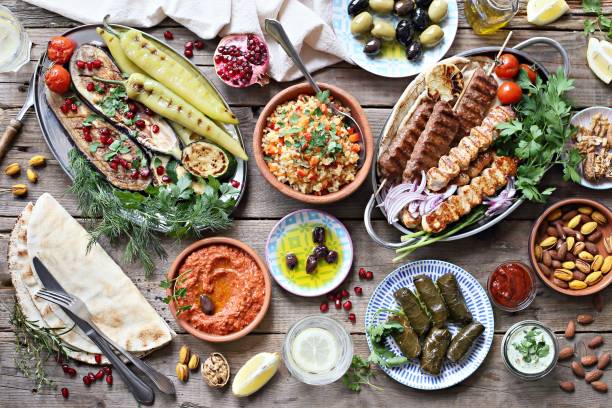Greek cuisine is a Mediterranean cuisine. Greek cookery makes wide use of vegetables, olive oil, grains, fish, wine (white and red), and meat (including pork, poultry, veal, lamb, rabbit and beef). Other important ingredients include olives, pasta (especially hilopites, a kind of pasta similar to tagliatelle), cheese, lemon juice, herbs, bread, and yogurt. The most commonly used grain is wheat; barley is also used. Common dessert ingredients include nuts, honey, fruits, and filo pastries. It has a history of thousands of years with dishes originating from Ancient Greece, continuing into the Byzantine period and surviving until today. It has been influenced by Middle Eastern, Ottoman, and Italian cuisine and cuisines from the northern countries while also having exerted influence over these same areas throughout the years.

Greek cuisine has a culinary tradition of some 4,000 years and is a part of the history and the culture of Greece. Its flavors change with the season and its geography. Greek cookery, historically a forerunner of Western cuisine, spread its culinary influence, via ancient Rome, throughout Europe and beyond. It has influences from the different people’s cuisine the Greeks have interacted with over the centuries, as evidenced by several types of sweets and cooked foods.

Ancient Greek cuisine was characterized by its frugality and was founded on the “Mediterranean triad”: wheat, olive oil, and wine, with meat being rarely eaten and fish being more common. This trend in Greek diet continued in Roman and Ottoman times and changed only fairly recently when technological progress has made meat more available. Wine and olive oil have always been a central part of it and the spread of grapes and olive trees in the Mediterranean and further afield is correlated with Greek colonization.[5][6]
Byzantine cuisine was similar to ancient cuisine, with the addition of new ingredients, such as caviar, nutmeg and basil. Lemons, prominent in Greek cuisine and introduced in the second century, were used medicinally before being incorporated into the diet. Fish continued to be an integral part of the diet for coastal dwellers. Culinary advice was influenced by the theory of humors, first put forth by the ancient Greek doctor Claudius Aelius Galenus. Byzantine cuisine benefited from Constantinople’s position as a global hub of the spice trade.
Typical dishes
Greek cuisine is very diverse and although there are many common characteristics amongst the culinary traditions of different regions within the country, there are also many differences, making it difficult to present a full list of representative dishes. For example, the vegetarian dish “Chaniotiko Boureki” (oven baked slices of potatoes with zucchini, myzithra cheese and mint) is a typical dish in western Crete, in the region of Chania. A family in Chania may consume this dish 1–2 times per week in the summer season. However, it is not cooked in any other region of Greece. Many food items are wrapped in Filo pastry, either in bite-size triangles or in large sheets: kotopita (chicken pie), spanakotyropita (spinach and cheese pie), chortopita (greens pie), kreatopita (meat pie, using minced meat), kolokythopita (zucchini pie) etc. The Greeks do with filo what the Italians do with pizza; They have countless variations of pitas (savory pies). Even the word pita was originally spelled πίττα (pitta), which shows a similarity to pizza. The areas with the largest tradition of making Greek pitas are the North-Western (Epirus) and Central Greece (also called Roumeli). Also, a big part of the Greek Cuisine are seeds and nuts. Seeds and nuts are included in everything from pastry to main dishes.
